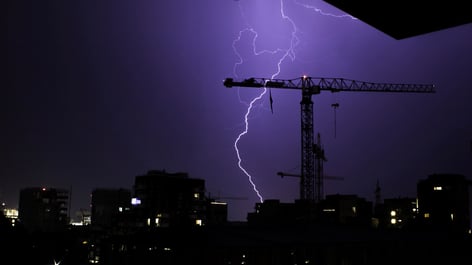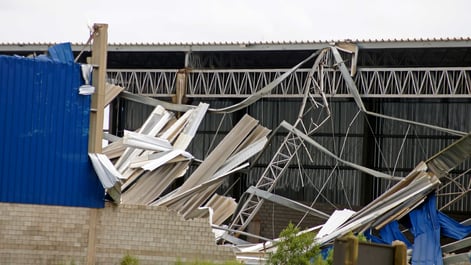When minutes matter: how to plan for and respond to a SkyGuard Tornado Warning
.jpg?width=2000&height=1125&name=tornado%20(2).jpg)
Summary
Best practices for implementing tornado warning procedures into a business emergency action plan.
Key Highlights
Plan ahead: Site-and threshold-specific alerts are a key part of a site safety plan
Operational challenges: Account for equipment shutdown time and time to travel to shelter area
Reduce vulnerability: Trust AccuWeather meteorologists to keep you and your employees safe
Tornadoes can form anywhere, including well outside what’s known as “Tornado Alley.” While they may be found most likely in the Plains, Midwest, and Southeast during the spring and early summer, tornadoes frequently occur outside those areas during all times of the year, so they should be a hazard accounted for in all site safety plans. Did you know that when tornadoes are in the forecast, we provide 16 minutes of advance notice compared to an average of eight minutes from other sources? Our false alarm rate is also less than anyone else. If you are not getting SkyGuard® warnings from AccuWeather For Business, you are putting the lives of your employees and customers at risk, not to mention your property and profits.
AccuWeather's 100+ expert meteorologists constantly look at the radar when severe weather threatens. Radar interpretation can give our meteorologists a good idea of the approximate winds within a tornado as it is ongoing, but the actual strength and rating of a tornado is not determined until after the event. The National Weather Service conducts damage surveys to assess a tornado's start and end time and rate the tornado on the Enhanced Fujita (EF) Scale.
Protective actions should always be taken during a tornado warning without waiting for visual confirmation, as tornadoes are not always seen due to being rain-wrapped or when occurring at night.
Before a Tornado Warning
When minutes matter, knowing exactly how to respond during a tornado warning is key. SkyGuard® Tornado Warnings are issued for a tornado passing within a user-defined radius of a set location, so receiving a warning means immediate action needs to be taken.
-1.jpg?width=734&height=413&name=GettyImages-168276092%20(1)-1.jpg) Organizations should consider these key questions:
Organizations should consider these key questions:
- How long does it take for outdoor equipment to be secured?
- How much loss will occur during an emergency shutdown of equipment?
- How long does it take for all on-site personnel to reach a place of shelter or refuge?
Your business’s severe weather safety plan should be tested annually, taking into account past events that can inform improvements and any organizational changes to procedures or personnel.
During a Severe Weather Event
Once your organization is set to receive site-specific severe weather warnings from AccuWeather For Business, site safety managers should ensure the warnings are actionable triggers and that warnings will be received by appropriate on-site personnel.
Additionally, AccuWeather For Business’s business preparedness experts recommend placing protective action instructions directly within the warning text. Staff should be familiar with their site’s emergency plan, but integrating emergency response instructions into the warning message will add redundancy that may make their response more efficient. 
Once a SkyGuard® Tornado Warning is received, immediate action should be taken in accordance with emergency procedures. This may include shutting down and evacuating equipment such as cranes or towers and securing any objects that could become dangerous wind-driven debris. All plans should account for the time required to reach shelter and ensure sheltering locations can accommodate every person on-site, including visitors.
AccuWeather For Business may also issue a SkyGuard® Null Notification, meaning that the National Weather Service has issued a Tornado Warning for the area but that a tornado is not expected to enter a 5-mile radius of your facility within the next 30 minutes. When you get this null notification, it lets you know that AccuWeather has reviewed the government warning. This will help prevent unnecessary and costly shutdowns.
A Partnership That Saves Lives
AccuWeather meteorologists are always monitoring your location, ready to notify your team when a hazard is imminent. Our services enable safety managers to know when to act to protect a facility, and our meteorologists are always just a phone call away to help inform your decisions.
Severe weather cannot be prevented, but you can reduce your organization’s vulnerability by knowing exactly how you’ll respond and staying as informed as possible with the site—and threshold-specific SkyGuard alerts.
Benefits of SkyGuard® Warnings
- Act as the trigger within an Emergency Action Plan, mobilizing resources and preparing for storm impact, minimizing weather-related risks and losses
- Proactive, site-specific alerts offer advanced warning well before severe weather impacts occur, ensuring the safety of employees
- Tailored to an organization’s thresholds based on equipment and needs of the operation
- Reduce false alarms and minimize service interruptions, ultimately saving time and money
- Accompanied by adaptable situational awareness tools as well as direct consultation with a meteorologist
Learn more about how AccuWeather's SkyGuard Notifications can help protect your people, property and profits. Talk to an expert today.







